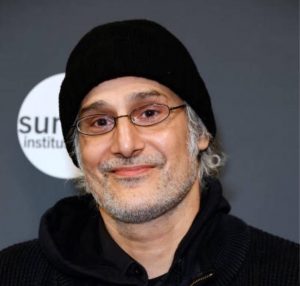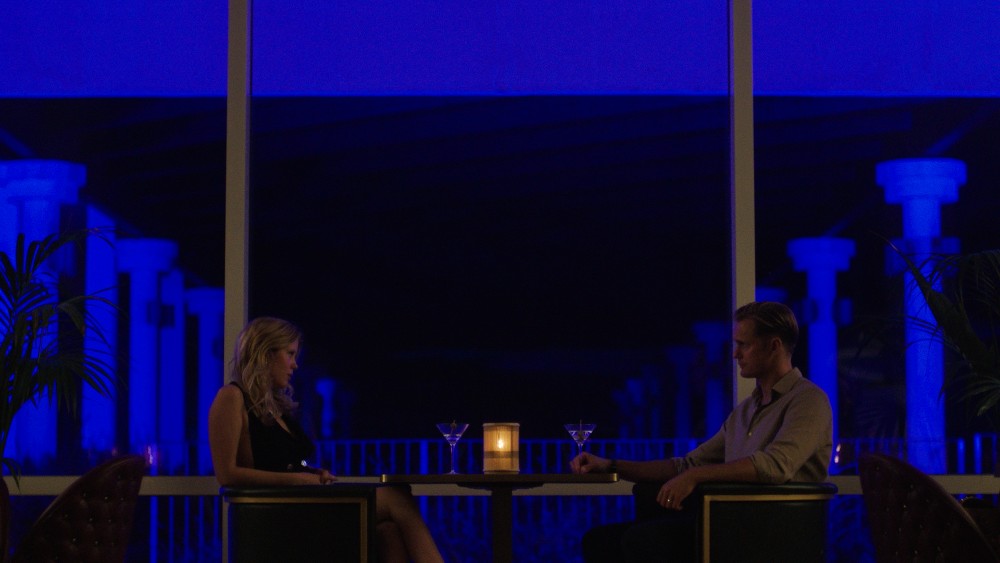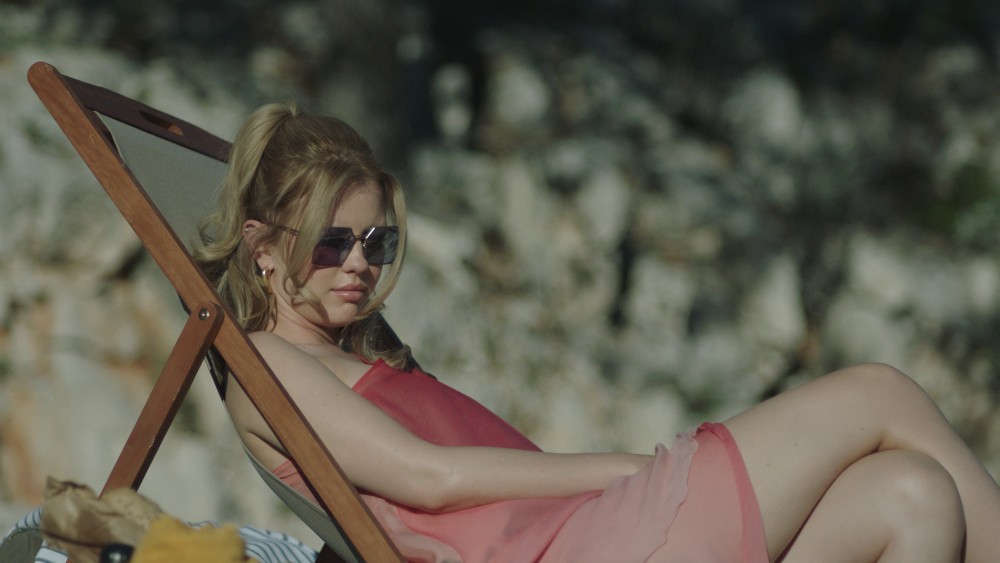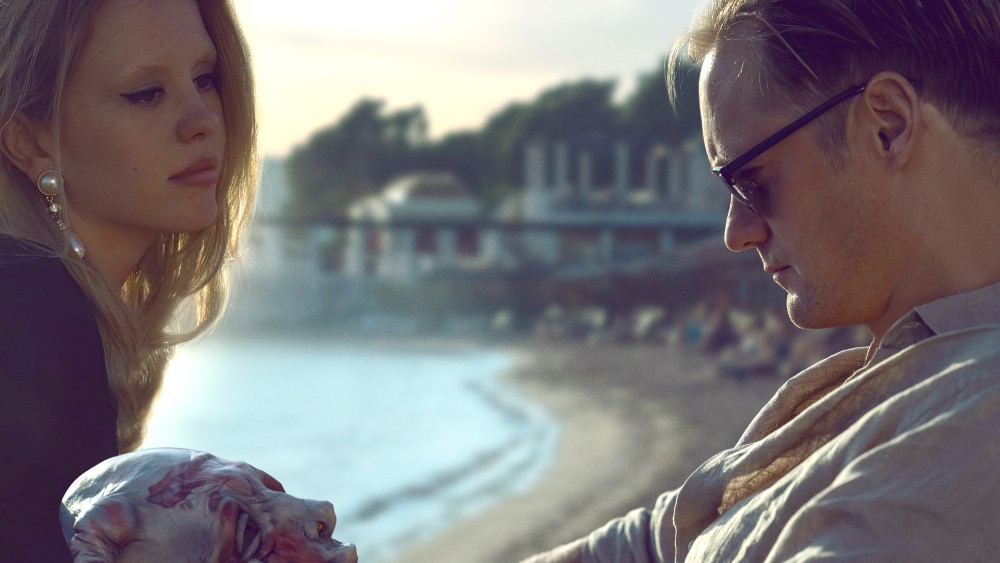Brandon Cronenberg‘s last two films, Possessor and Infinity Pool, look so unique and distinctive from all other movies out there, genre or otherwise. That’s a direct result of his ongoing collaboration with Cinematographer Karim Hussain, CSC, is a legend among Canadian genre fans, having shot a number of local horror movies such as Ted Geoghegan‘s We Are Still Here and Jay Baruchel‘s Random Acts of Violence. He’s also an involved presence at Montreal’s annual genre fest, the Fantasia International Film Festival, where many of his movies have premiered.
Hussain’s films usually use colors and colored lighting in ways that really stand out and give his work an almost luminescent quality, although his films with Cronenberg have been especially next-level in terms of the experimentation that the two of them incorporate into both their production and post-production processes.
Their latest collaboration, Infinity Pool, stars Alexander Skarsgård (The Northman) and Cleopatra Coleman (Dopesick) as James and Em, a wealthy couple who travel to a luxury vacation resort in a fictional country, where they meet Mia Goth‘s Gabi and her husband, Alban (Jalil Lespert). The latter couple introduces the former to the country’s unconventional judicial system following a hit-and-run incident before leading them on a criminal and sexual romp during which they test the limits of that system.
Below the Line spoke with Hussain over Zoom a few weeks back and he spoke in-depth about how he worked with the younger Cronenberg to create the distinctive look for Infinity Pool, as well as his collaboration with the crews in Hungary and Croatia, where the film was shot.

Below the Line: It’s great to finally talk to you. I feel like we’ve probably been in the same room together at some point, perhaps for some of the Fantasia premieres I’ve attended, like Ted Geoghegan’s Mohawk, though we weren’t introduced. Before we get into your work with Brandon Cronenberg, I’m curious about your background and how you found your way to cinematography.
Karim Hussain: I come from a more unusual background, in [the] sense that I come from underground horror movies. I’ve never been to film school. In fact, I got kicked out of high school when they thought I was making obscene movies, and unfortunately, like a fool, I was making arthouse horror movies, always. The horror genre has always been my passion and is 100 percent still my passion. I was making these pictures on Super 8 film because back then, that’s what we used.
I just basically came from a DIY underground background a bit like how Peter Jackson started, or John Waters. You would just start making underground movies, and then, from there, I met up with my friend Mitch Davis, who’s now the director of the Fantasia Film Festival. We were just a bunch of horror fans. After I got kicked out of high school in Ottawa, Canada, I went to Montreal and met Mitch, just at a horror film festival, and then we got together, of course, [and] Fantasia happened, and we embarked on my first feature film, [which] took six and a half years to finish. A 16mm movie, [a] very underground filmmaking style thing where I would direct the movies as well as shoot them. That one I co-shot, and then, afterward, that movie was successful in Japan, of all places, and played some festivals.
I had gone on to direct and photograph two other features, and some short movies. Those movies were a little bit better known in Europe, and then a French director named Gilles Paquet-Brenner made a now-forgotten movie in Canada called Walled In, which was an Anchor Bay release back in the day. He was going to come in to do this movie in Canada, and a French journalist recommended me as somebody who knew the horror genre. It was his first horror movie, and he wanted somebody who knew the background as a cinematographer.
For me, it was a huge leap, because my most expensive movie at that point was 1.2 million Canadian dollars, and that, at the time — it was a long time ago — was $8 million dollars U.S. and probably cost about $20 million to make that movie, so it was a huge leap ahead. That was back when everything was on film, so that was in 35mm. I learned a lot, and since then, I haven’t looked back. I’m only a cinematographer, and I basically learned on the job. I learned from doing it and from reading books and American Cinematographer magazine, things like that. I learned from basically doing it.
BTL: Did you meet Brandon in those same horror circles while you were coming up?
Hussain: Brandon, who is a big horror fan and really loves the genre, I only met through his first feature, Antiviral, which now, at this point, is quite some time ago. I had done a movie called Hobo With a Shotgun for [some] producers in Toronto named Rhombus, and Rhombus was producing Brandon’s first feature film, Antiviral. We just met, because they were looking for a DP, and we got along instantly, and since then, he’s been like a member of the family. [We’re] friends. From Antiviral, we met there, but immediately, the instant we met, I knew I met somebody very important in my life, and also just an amazing and brilliant human being.
BTL: You did that and Possessor with him, and the latter had a strange release because it came out here when there were no movie theaters open in New York or L.A. at the time. I’m not sure if they were open in Canada, but I still haven’t seen it in a theater. When did he tell you about Infinity Pool? He told me that it was a short story, so had you read any iterations of that story over time?
Hussain: The way we work with Brandon’s movies is a bit like being in a band, so to speak. There’s a core group of friends [and] we do everything together. We develop the pictures together. We all consult on all aspects of the script. [Producer] Rob Cotterill is certainly part of that, and we have various producer friends [who] are always a part of that development process as well.
Infinity Pool started as a very short comic that was published in Ontario. The comic at the time was called Death in Letolka. Letolka is, of course, the name of the fictional country that Infinity Pool takes place in. That was the beginning of it, and then Brandon, based on that comic book, went and developed a feature. It was also based on his experiences when he went to resorts and saw the various sorts of things that can happen within that universe. Even some of the more scandalous things you see in the movie that take place [at] the resort are literal, actual things that Brandon did see on some of these tourist resorts — cultural appropriation, things like that. Those things in the movie are actually things he saw, and the movie is quite a scathing critique of that kind of thing.
It developed throughout that time, and it was developed before we shot Possessor. We had a screenplay ready, and we actually scouted in Croatia and Hungary before we went to shoot Possessor. Possessor was a very long process, to get a greenlight on, to cast it. It kept on starting [and] stopping. We were doing a lot of camera tests during that time period, with experimental camera techniques and things like that, that we incorporated in Possessor and then built upon for Infinity Pool. They’re all practical and done in camera; there’s no CGI in any of those hallucination sequences; everything is done in front of the camera practically. We had to develop a lot of unusual techniques and ways of shooting and reshooting that stuff with basically live opticals.
The development process was over years, as always, and we had to take a pit stop to finally make Possessor before Infinity Pool came. Karen Harnisch, Andrew Cividino, [and] Rob Cotterill are excellent producers. Of course, NEON came on board because of Possessor, and NEON was amazing. Elevation, our Canadian co-producers, were absolutely wonderful, too. It was a real core team that worked together to preserve the vision, and Brandon was able to see that vision through, which we’re very thankful for. We didn’t have any producer interference saying, “You gotta do this. You gotta do that.” It was actually really freeing and liberal, so that was wonderful.

BTL: It must be nice to have a studio like NEON that understands art films and the potential for them to lure bigger audiences. I was surprised when I spoke to Brandon when he said he didn’t storyboard at all. I’m only surprised by that because I spoke to his father [David Cronenberg] a few times, and he doesn’t storyboard either. He just shows up on set or on location and just decides with the actors where to place them and the camera, which is quite unusual, but it seems to work.
Hussain: We shot list really meticulously. Where David has his technique of doing things, and obviously, it works for him — one of the great filmmakers of the world, David is — but with Brandon, we shot list everything really meticulously. We don’t storyboard, just because we have such a clear vision in our minds of what the shots and the compositions are. If you read our shot list, they’re like books, describing what the lens will be, the angle, when we pivot [our] axis and everything. We’re not like David’s technique where he just shows up and says, ‘Okay, let’s do this.’ We have a very precise plan of what we want to do before we hit the floor. We just don’t draw it out, but it is definitely written in very many words.
BTL: I know Budapest has a pretty good infrastructure in general for film and television, but I’m not sure about Croatia. When you got there, how hard was it to get the cameras and lenses you needed? Did you have to bring a lot of that stuff with you?
Hussain: Budapest has a very good film industry and certainly some very good crew members, but it was incredibly busy. See, when we were there, things were constantly changing. It was a real challenge. I wouldn’t say it was easy. Not that it needed to be, but there were a lot of challenges. Also, to make a movie like this one, if a Marvel show is in town, the Marvel show will get all the best equipment. Or they’ll promise you certain pieces of equipment, and then you’ll show up on the day, and then it’s not what they promised, or there’ll be things like that, that will take place merely because it is very much the “rich get the most” economy over there. While we weren’t a small movie, by any means, we [didn’t have] Marvel money, so that kind of thing was a challenge. But everybody stepped up to it, and again, there were some really good crew members [who] came from Hungary and Croatia [and] were really cool. We all overcame the challenges, but it wasn’t that easy. It was definitely an intense shoot — not in terms of the content. The content was easy. It was more just production issues.
BTL: Considering you do all this development and experimenting of the things you’re going to do, how hard is it when you set up camp in Croatia, which I assume is fairly early, so you can find what you need to recreate the earlier experiments?
Hussain: We had experimented with some stuff in Canada, and then we continued with a few extra camera tasks when we were in Hungary. The way the movie worked was, we went to Hungary first, we prepped there, then we went to Croatia, prepped a bit in Croatia at the tourist resort — the entire exterior of the tourist resort is in Croatia. And then the Hungarian locations were more the off-resort stuff or some interiors, the sort of stage that we got over there to shoot some of the orgy and the hallucinations and things like that. It was going back and forth between Hungary and Croatia a lot. We continued some of the experimentation there, but we just went on set.
We knew already, based on our experience from Possessor and our additional tests, what we wanted to do and the different sorts of techniques we wanted to use, where we used a certain type of film called dichroic film. Dichroic film is a certain type of film that, depending on the angle you look at it, the color changes. We would wrap that around what is known as a split field diopter. Essentially, that’s a magnifying glass cut in half that you would put in front of a lens that you see in, for example, Brian De Palma movies or things like that where a split field diopter is seen.
Brandon would hand-hold that with the dichroic film draped over the split filter diopter and shine a light into it, so the color would change wherever the light would move, and then we would re-photograph the rushes that we took on set in my living room, where a lot of this stuff takes place. It’s usually just Brandon and myself rephotographing the stuff. I’m doing the playback [and] taking care of the camera, and Brandon is in front of the lens, just puppeteering these effects manually by hand.
Because we do this before the editing of the sequences, we have to do every single piece of the rushes that we shot. It’s quite a long and arduous process and all very manual, done by hand. You can tell when you see it that [it’s] not a CGI effect. There’s something very organic and odd feeling about it, so that’s a part of our technique. We do everything live in front of the camera. We don’t rely on computer graphics and CGI.
BTL: But you’re also not making the actors wait around while you’re doing all that stuff, most of that is done afterward in the post process, right?
Hussain: We do a lot of that with the actors, too. Sometimes, for some scenes, it’s a combo of both. I think Alex and Mia, in particular, who were doing entire sequences with them in this weird strobe vortex with projections on them, would sit in a chair and we would wave the split-fill diopters and the lights around. It looks like a really weird puppet show, but no, we did that live with the actors, too. Also, range projection and double projections — we just augment it afterward in post by actually rephotographing, even some stuff that is already processed on set. So no, we do it with the actors as well.

BTL: One thing we don’t really discuss with cinematographers that much is possibly one of their most important attributes — making the actors look good. What is your process as a cinematographer? Do you talk to the actors beforehand in case they have “better sides” and such?
Hussain: It depends on the movie. Every movie has [a] different vibe and different ideas. As long as the look is consistent to the intentions of the mise en scene and the director’s intentions then anything goes. If you’re in a scenario where you want to do glamour lighting, so to speak, then I just look at a lot of their previous work, and I see what other cinematographers have done with the lighting on them. I study the architecture of their face and study how light falls on their face.
Certainly during camera tests, if you have the performer available, that’s extremely helpful, where you can go and see them and just see [which] is their good side, how the light plays on their face. That’s something that you obviously do research on that, and unless the performer comes up to me, and says, “This is a certain thing” — which I’ve had before, where performers come up to me and say, “This is how light looks good on me.” Unless they come up to you and say that, then I tend to just do it without bothering them. A performer has so much stuff to consider and think about that I don’t want to put that in their brains. “Don’t worry, I’ll make [you] look good,” and I do my best.
BTL: You spoke a little about the crews in Croatia and Budapest. Have you generally shot most of your movies in Canada or have you traveled to a lot of different places for the movies you’ve shot?
Hussain: I’ve shot around the world. I’ve shot a lot in Europe. I’ve shot in Jordan. We did Hungary [and] Croatia. I shot a short movie in Sweden. I worked a lot in France, and yeah, I mean, basically, the basic desires and rules of crews are pretty similar around the world. There are some technical differences. In terms of who completes the lighting in Europe, the electrics basically do all the aspects of lighting. In North America, the grips are also lighting grips [who] not only do the camera positioning but they’re also involved with cutting the light and shaping the light and things like that in North America. It’s a little different in terms of who does what.
In general, they’re [all] professionals and working in cinema, [you] start from a point of passion and then try to do things. Of course, there are language barriers [and] there are cultural differences, which means sometimes there’ll be challenges working in different cultures, and you try to adapt the best you can. It’s not like you’re gonna be able to impose your culture onto another place, if you’re in another place. They’re the host, and you’re the guest, so you do your best to try and make it work within that context. It’s not always a simple process, considering maybe something was budgeted and structured to fit a more North American approach, but you try to be honest with people and try to do things as cool as you can.
BTL: Do you generally try to find at least one person who speaks English? I assume you speak French as well, but if you find one person heading a specific department, can you use them to translate for the crew who might not?
Hussain: In Hungary, I felt that not a lot of people spoke English. There was some, I’m sure. Certainly, if you’re on the Marvel show, everyone’s gonna [speak English]. Seeing how busy the city was, I had a situation where I had two gaffers on the movie, which is always a challenge. And [it’s] not like one gaffer [was] doing one piece of the movie and another gaffer [was] doing another piece. No, this is two at the same time — one was Croatian [and] one was Hungarian.
The Croatian gaffer, who was wonderful, spoke English, and the thing is, he didn’t speak Hungarian. After I gave him my English instructions, for the most part, then he would have to relate in English to a Hungarian crew that wasn’t fluent in English instruction. There were a few extra steps to go through, but we got it done and it was good. [There are] very good grips over there; the Hungarian grips are wonderful. The Hungarian camera team, I think, was really great.

I had a wonderful B-camera and second unit director of photography over there called Agnesh Pakozdi, who is a Hungarian woman, but living in Germany. I had to go through a few hoops to find her, but she still had her Hungarian citizenship and everything, so she could do the movie. And she’s wonderful, and [did] amazing B-camera and second unit work on the movie. She’s also a director of photography of renown on her own end, so she actually demoted herself to do B-camera and second unit on the picture, but [it was] much appreciated because their work is phenomenal, and she’s just a really good human being, which is the type of [person] I prefer to work with.
BTL: Since we have a lot of readers who work in camera, do you have any go-to cameras or lenses that you try to have for every shoot no matter who you’re shooting with/for?
Hussain: Every movie is different, so I try to keep it varied between movies, but on Brandon’s movies, particularly with a short film we did called Please Speak Continuously and Describe Your Experiences as They Come to You — long title, short film — we were using the various versions of the ARRI Alexa, so either the Alexa Classic, the ARRI Amira, or the Alexa Mini — that’s the order of [how] we used them. We were always using vintage Canon K35 lenses from the late ’70s on them as our main prime lens, [and] then I have a 1970 original Angenieux 25 to 250 zoom lens, which we have nicknamed “Lucky Pierre.” Lucky Pierre has been playing on… it’s kind of a trilogy of Brandon movies, the short and the two features — the two features being Possessor and Infinity Pool, and the short being the one with a really long title.
Those pictures all have a unified look, but [they] develop as they go. I think Infinity Pool is sort of the sum of all the parts of those experiments we did. So Canon K35s, Lucky Pierre as our zoom lens, no diffusion, and a very important part of those movies is, we use the compression format on the camera as diffusion and not actually glass. All of those movies in this world — everyone’s like 4K, 8K, 12K! We shot them in 2K ProRes 4444, not even ProRes XQ which is a higher resolution type of ProRes, simply because it led to a softer image when we blew it up to 4K. The correct version of watching this movie is in 4K. Everything is designed to shoot at 2K with the blow-up to 4K in mind. The correct display of the thing should be in 4K. The DCPs you’re looking at should be in 4K, and we shoot everything at a higher ISO as well. All of those movies are shot at 1280 ISO, so there’s more grain naturally built into the image. That’s why a lot of people think, particularly with Infinity Pool, [that it] was shot on film, because it has that softer patina, and we use a lot of lenses with chromatic aberration like the K35s or like Lucky Pierre, the zoom lens, which are really chromatic aberration-friendly lenses.
In the highlights, it almost looks like halation sometimes that you would get from film. Not exactly, but people feel things more instinctively unless they have a really precise technical eye. The compression format was a part of getting that smoother, silkier look that we got. Obviously, with the digital management technician in Jim Fleming, our final color grader at Company 3 in Toronto, we worked on a softer contrast look but made sure that certain colors would punch, like, the blues in Infinity Pool are particularly strong around the hotel — things like that. Those are meant as sort of color punches, color shock, to just go and assault you occasionally.
BTL: It’s so great to talk to you finally. You’re probably going to end up shooting a Marvel movie, and I’m going to have to give you shit for it since you’ve been trashing Marvel so much.
Hussain: [laughs] I’m not bashing Marvel. I’m just saying they steal all my equipment! [laughs]
Infinity Pool is still playing in select theaters but it’s also available to buy or rent on all major VOD/digital platforms, including iTunes, Prime Video, and YouTube.





